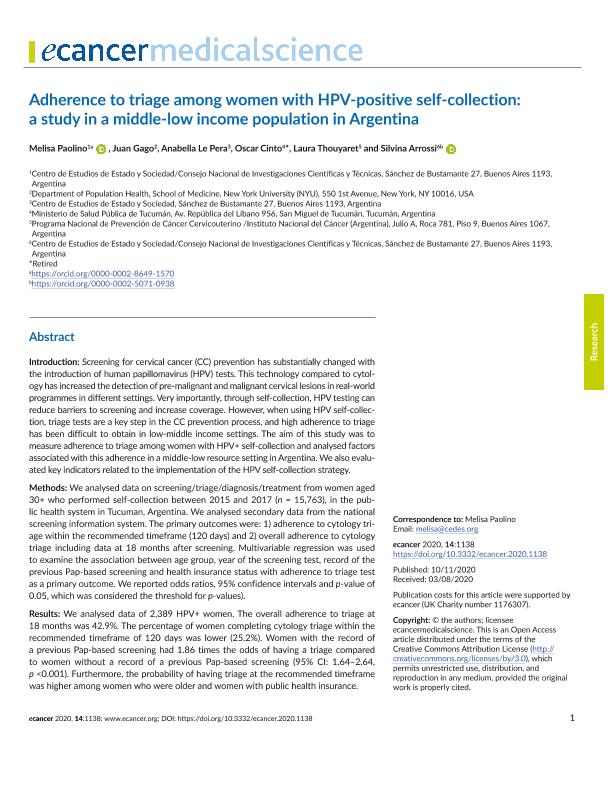Artículo
Adherence to triage among women with HPV-positive self-collection: A study in a middle-low income population in Argentina
Paolino, Melisa Delia ; Gago, Juan; Le Pera, Anabella Hebe
; Gago, Juan; Le Pera, Anabella Hebe ; Cinto, Oscar; Thouyaret, Laura; Arrossi, Silvina
; Cinto, Oscar; Thouyaret, Laura; Arrossi, Silvina
 ; Gago, Juan; Le Pera, Anabella Hebe
; Gago, Juan; Le Pera, Anabella Hebe ; Cinto, Oscar; Thouyaret, Laura; Arrossi, Silvina
; Cinto, Oscar; Thouyaret, Laura; Arrossi, Silvina
Fecha de publicación:
10/11/2020
Editorial:
ecancer Global Foundation
Revista:
ecancermedicalscience
ISSN:
1754-6605
e-ISSN:
1754-6605
Idioma:
Inglés
Tipo de recurso:
Artículo publicado
Clasificación temática:
Resumen
Introduction: Screening for cervical cancer (CC) prevention has substantially changed with the introduction of human papillomavirus (HPV) tests. This technology compared to cytology has increased the detection of pre-malignant and malignant cervical lesions in real-world programmes in different settings. Very importantly, through self-collection, HPV testing can reduce barriers to screening and increase coverage. However, when using HPV self-collection, triage tests are a key step in the CC prevention process, and high adherence to triage has been difficult to obtain in low-middle income settings. The aim of this study was to measure adherence to triage among women with HPV+ self-collection and analysed factors associated with this adherence in a middle-low resource setting in Argentina. We also evaluated key indicators related to the implementation of the HPV self-collection strategy. Methods: We analysed data on screening/triage/diagnosis/treatment from women aged 30+ who performed self-collection between 2015 and 2017 (n = 15,763), in the public health system in Tucuman, Argentina. We analysed secondary data from the national screening information system. The primary outcomes were: 1) adherence to cytology triage within the recommended timeframe (120 days) and 2) overall adherence to cytology triage including data at 18 months after screening. Multivariable regression was used to examine the association between age group, year of the screening test, record of the previous Pap-based screening and health insurance status with adherence to triage test as a primary outcome. We reported odds ratios, 95% confidence intervals and p-value of 0.05, which was considered the threshold for p-values). Results: We analysed data of 2,389 HPV+ women. The overall adherence to triage at 18 months was 42.9%. The percentage of women completing cytology triage within the recommended timeframe of 120 days was lower (25.2%). Women with the record of a previous Pap-based screening had 1.86 times the odds of having a triage compared to women without a record of a previous Pap-based screening (95% CI: 1.64-2.64, p <0.001). Furthermore, the probability of having triage at the recommended timeframe was higher among women who were older and women with public health insurance. Conclusions: Our results showed that adherence to triage in the recommended timeframe was low. In addition, the probability of having triage at the recommended timeframe was higher among women with a record of a previous Pap-based screening, a proxy of the use of health services. Our results showed that adherence to triage in the context of the HPV-self-collection strategy is challenging. The implementation of alternative approaches that might facilitate adherence to triage should be further investigated.
Archivos asociados
Licencia
Identificadores
Colecciones
Articulos(SEDE CENTRAL)
Articulos de SEDE CENTRAL
Articulos de SEDE CENTRAL
Citación
Paolino, Melisa Delia; Gago, Juan; Le Pera, Anabella Hebe; Cinto, Oscar; Thouyaret, Laura; et al.; Adherence to triage among women with HPV-positive self-collection: A study in a middle-low income population in Argentina; ecancer Global Foundation; ecancermedicalscience; 14; 10-11-2020; 1-14
Compartir
Altmétricas



